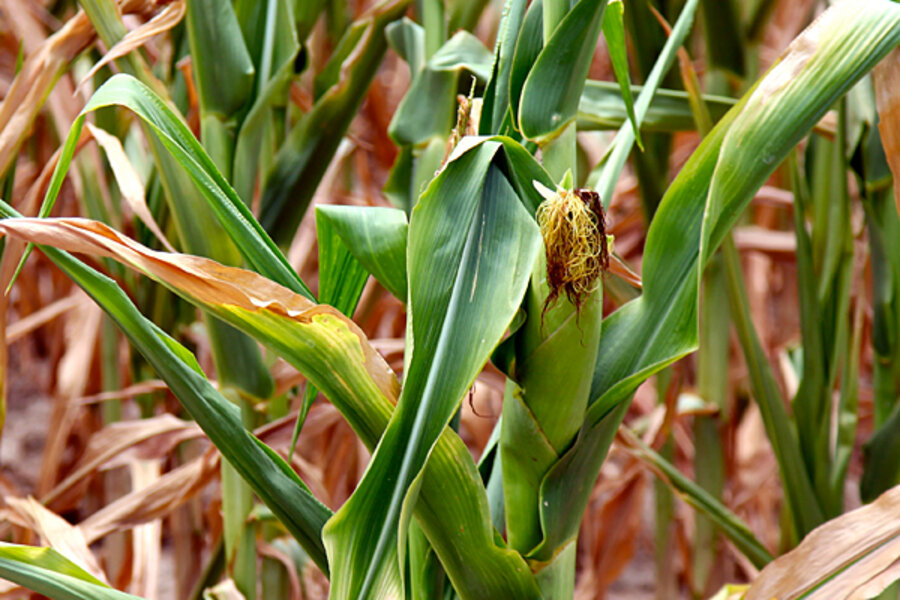Amid unusually widespread drought, warnings on food prices
Loading...
| Los Angeles
Farmers from Illinois to Wyoming are watching crops and livestock wither as the most widespread drought since 1956 persists across more than half the US, and higher food prices won’t be far behind.
Already, the US Department of Agriculture has lowered its crop projections for corn by some 12 percent, and the price of corn has jumped 34 percent in the past months alone. As corn – one of the hardest hit crops – is one of the main ingredients in everything from, well, corn flakes to cattle feed, experts say a rise in food prices is inevitable.
“Prices are going to go up,” says Justin Gardner, assistant professor of agribusiness at Middle Tennessee State University. “The only question is when.”
The first categories to be hit, he says, are meats, such as beef, poultry and swine. But “figuring how quickly the pocketbook will get hit is a bit tricky,” he notes, “you have to figure how long it takes to move corn into cattle and into your grocery store.”
Americans are probably already seeing the drought’s impact, and it will get worse before it gets better, says Jeff Born, a finance professor and director of the executive MBA program at Northeastern University in Boston.
He visited parts of the afflicted area a couple of weeks ago and says there has been no significant relief with rain. He points out that while corn is resilient, if the stalk dies the ears cannot get water no matter how much rain falls later.
Bottom line, he says via e-mail, is that “if you like bacon/pork you should buy it now, because by the fall you are going to be stunned at what it will cost.”
USDA officials, however, are predicting a less dramatic impact on food prices. According to USDA estimates, only 14.6 cents of every grocery dollar goes to farmers or ranchers. Labor and processing make up a much larger part of the cost of food, points out Professor Gardner, adding that “the impact of the drought won’t really change those costs.”
The USDA calculates that overall prices rise one percent for every 50 percent increase in the price of corn. On Sunday, Agriculture Secretary Tom Vilsack appeared on CNN’s “State of the Union” to say it’s too soon to see the crop losses now being witnessed across the nation’s bread basket translate into sticker shock at the grocery store.
While commodity prices will likely increase, he said, “it will have a marginal impact on food prices.” He added that energy prices drive up food prices more significantly.
“The prices and the impact of a drought probably will not likely be seen in the grocery aisles until later next year, 2013,” he said.
But according to farmer Steve Ford, who is an associate professor of economics at The University of the South in Sewanee, Tenn., the outlook may be gloomier than government statistics project.
"My sources in the Midwest tell me that the drought is actually worse than indicated in USDA's recent yield estimates,” he says via e-mail. He says the USDA estimates of a 12 percent decline in corn yields were from “overly optimistic initial yield estimates.” He suggests that farmers will more than likely see close to another 10 percent decline in yield.
Even so, he adds, projected corn production in 2012 is still higher than the levels in 2010 or 2011. What will make the difference is global demand, which is higher. As far as the economics of livestock, he points out that much of the adjustment to higher feed costs has already been made through reductions in animal numbers.
However, he adds, “it will still be hard for those remaining in business this year. The issue will be how many will remain in business until grain prices decline.”
How hard your bottom line is hit depends on where you are in the food chain, says Scott Rothbort, publisher of The LakeView Restaurant & Food Chain Report and president of Lakeview Asset Management in Milburn, N.J.
Large companies such as Kellogg’s and General Mills hedge their losses in the marketplace, protecting themselves from small price gyrations of the marketplace for up to six months. Restaurants and other food vendors do the same, with longterm contracts that lock in price stability.
Even farmers have crop insurance to cover their losses, a federal program that by some estimates may top $30 billion in 2012. “But prices for the average consumer at the grocery store will be more problematic,” he says, adding, “certainly fresh produce, meat, and baked goods will be impacted.”
The weather may not help out any time soon, points out Clark University drought expert Christopher Williams.
This drought is unusual, he says, because normally they tend to be “patchy,” meaning that while one area of the country is experiencing drought, others are compensating with other weather.
But what makes this drought “so impressive is that it is largely continuous.” More than half the country is engulfed by this drought, he points out, adding, “that makes it special,” and the longer term impact less clear.





